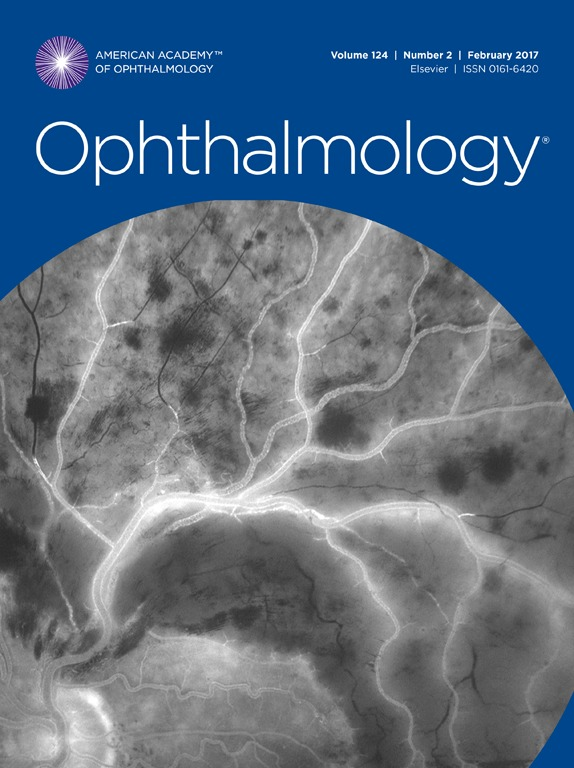青光眼药物的疗效和药物相互作用:系统综述和成分网络荟萃分析。
IF 9.5
1区 医学
Q1 OPHTHALMOLOGY
引用次数: 0
摘要
主题:探讨青光眼药物单药和联合用药降低眼压的疗效及不同类别药物间的相互作用。临床相关性:新引入的e -前列腺素受体激动剂(EP2)、rho激酶抑制剂(ROCKI)和各种联合疗法的治疗效果尚未在所有可用的青光眼治疗中进行评估。这些联合疗法的协同或拮抗作用尚不清楚。方法:Embase和PubMed检索到2025年5月20日之前的随机对照试验,比较局部青光眼单一疗法和联合疗法对原发性开角型青光眼或高眼压患者降低眼压的效果。评估的药物包括f -前列腺素受体激动剂、前列腺素类似物(PG)、一氧化氮供体前列腺素类似物(PGN)、EP2、α -2肾上腺素能激动剂(A)、β -肾上腺素能阻滞剂(B)、碳酸酐酶抑制剂(C)、ROCKI及其组合。采用基于对比的频率随机效应模型进行网络meta分析(NMA),计算不同治疗间眼压降低的加权平均差异。使用p分数确定疗效排名。使用RoB2评估偏倚风险,使用网络元分析置信度(CINeMA)评估证据的确定性(COE)。组分NMA(cNMA)用于探讨不同药物之间的相互作用。该研究已在PROSPERO注册(CRD42024573926)。结果:共纳入166项试验(36,494名受试者)。基于PG的组合显示出最大的IOP降低(-7.41 ~ -5.81 mmHg,低COE), PG+C排名最高。在单药治疗中,PGN最有效(-5.15[-6.18 ~ -4.11]mmHg,低COE),其次是PG (-4.75[-5.19 ~ -4.31] mmHg,高COE)和EP2 (-3.50[-4.27 ~ -2.73]mmHg,高COE)。ROCKI (-3.24[-3.85 ~ -2.63]mmHg,高COE)与A (-3.36[-3.85 ~ -2.86] mmHg,高COE)和B (-3.29[-3.71 ~ -2.87]mmHg,高COE)相当。非PG-based双药联合(-5.10 ~ -4.82 mmHg,低至高COE)的疗效与PG单药治疗相当,而非PG-based三联药联合(A+B+C, -7.22[-9.04 ~ -5.40]mmHg,低COE)的疗效与排名第一的PG-based联合相似。cNMA显示PG+B(1.26mmHg)和PG+ROCKI(0.84mmHg)之间存在拮抗作用,而PG+C(-2.05mmHg)之间存在协同作用。72%的混合比较具有中等到高的COE,而所有的间接比较具有低到非常低的COE。结论:与非PG为基础的三联用药相比,PG为基础的联合用药效果最好,尤其是PG+C。EP2优于其他非PG处理,但排名低于PG和PGN。PG+B和PG+ROCKI表现出拮抗作用,而PG+C的协同作用为新的组合提供了一条有希望的途径。本文章由计算机程序翻译,如有差异,请以英文原文为准。
Efficacy and Drug Interactions of Glaucoma Medications
Topic
To investigate the efficacy of monotherapies and combinations of glaucoma medications in reducing intraocular pressure (IOP) and drug interactions.
Clinical Relevance
The relative treatment efficacy and interaction of the newly introduced E-prostanoid receptor 2 (EP2) agonists, rho-kinase inhibitors (ROCKIs), and various combination therapies remain unknown.
Methods
Embase and PubMed were searched through May 20, 2025, for randomized controlled trials comparing IOP-lowering effects of topical glaucoma medications in patients with primary open-angle glaucoma or ocular hypertension. The medications evaluated included prostaglandin F2α analogs (PGFAs), nitric oxide-donating prostaglandin analogs (NO-PGA), EP2 agonists, unoprostone, α2-adrenergic agonists (AAAs), β-adrenergic blockers (BABs), carbonic anhydrase inhibitors (CAIs), ROCKIs, and their combinations. A network meta-analysis (NMA) using contrast-based frequentist random-effects models calculated the weighted mean difference in IOP reduction, with rankings determined using P scores. The risk of bias was assessed with Cochrane Risk of Bias Tool, and the certainty of evidence (COE) was evaluated using confidence in network meta-analysis. Component NMA explored interactions between different medications. The study was registered with the International Prospective Register of Systematic Reviews (identifier, CRD42024573926).
Results
Among 166 trials (36 494 participants), PGFA-based combinations demonstrated the greatest IOP reduction (range, −7.41 to −5.81 mmHg; COE: low), with PGFAs plus CAIs ranking highest. Among monotherapies, NO-PGA was most effective (−5.15 [95% confidence interval: –6.18 to –4.11 mmHg]; COE: low), followed by PGFA (–4.75 [−5.19 to −4.31]; high) and EP2 agonist (−3.50 [−4.27 to −2.73]; high). ROCKIs (−3.24 [−3.85 to −2.63]; high) were comparable with AAA (−3.36 [−3.85 to −2.86]; high) and BAB (−3.29 [−3.71 to −2.87]; high). Non-PGFA-based dual combinations (range, −5.10 to −4.82 mmHg; low to high) were comparable to PGFA, whereas non-PGFA-based triple combinations (AAA plus BAB plus CAI, −7.22 [−9.04 to −5.40]; low) were similar to the top-ranking PGFA-based combinations. Component NMA revealed antagonism between PGFA plus BAB (1.26 mmHg) and PGFA plus ROCKI (0.84), whereas synergy was observed with PGFA plus CAI (−2.05).
Discussion
Non-PGFA-based triple combinations and PGFA-based combinations, especially PGFA plus CAI, were the most effective. E-prostanoid receptor 2 agonists outperformed other non-PGFA treatments but ranked below PGFA and NO-PGA. Prostaglandin F2α analog plus BAB or ROCKI showed antagonism, whereas the synergy of PGFA plus CAI suggested a promising avenue for new combinations.
Financial Disclosure(s)
The author(s) have no proprietary or commercial interest in any materials discussed in this article.
求助全文
通过发布文献求助,成功后即可免费获取论文全文。
去求助
来源期刊

Ophthalmology
医学-眼科学
CiteScore
22.30
自引率
3.60%
发文量
412
审稿时长
18 days
期刊介绍:
The journal Ophthalmology, from the American Academy of Ophthalmology, contributes to society by publishing research in clinical and basic science related to vision.It upholds excellence through unbiased peer-review, fostering innovation, promoting discovery, and encouraging lifelong learning.
 求助内容:
求助内容: 应助结果提醒方式:
应助结果提醒方式:


